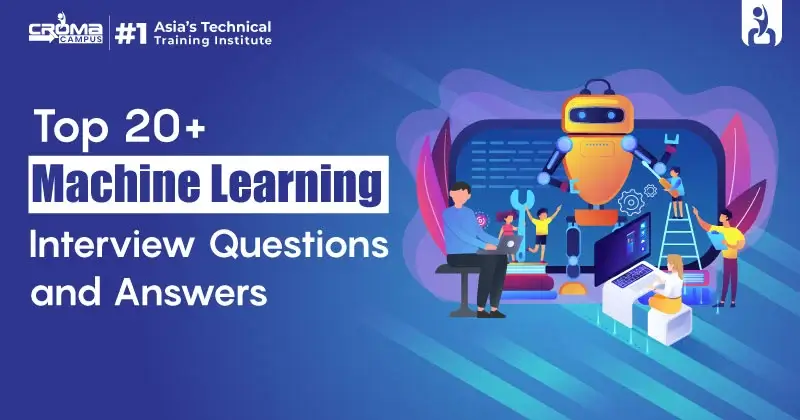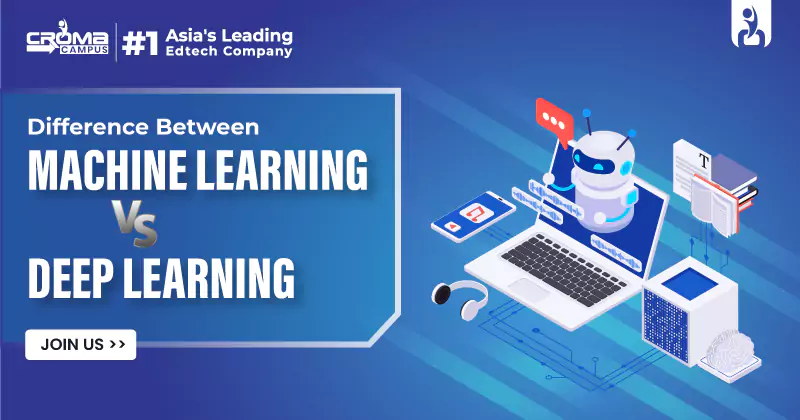Top 20 Machine Learning Interview Questions And Answers 2026
4.9 out of 5 based on 1210 votesLast updated on 22nd May 2023 13.7K Views
- Bookmark

When it comes to machine learning, it's important to understand the distinction between supervised and unsupervised learning.

Congratulations!
You've reached an exciting stage in your journey toward a career in machine
learning - the interview phase. This is your opportunity to showcase your
skills and passion for data science. To help you excel in your upcoming machine
learning interviews in 2025, I have crafted a list of the top 20 machine learning
interview questions along with their detailed answers.
This
comprehensive guide will equip you with the knowledge and confidence needed to
tackle any machine learning interview question that comes your way. If you have
completed any Machine Learning Training recently, these questions
will be covered as the part of training too under experts’ supervision.
- What is the difference between
supervised and unsupervised learning?
When it comes to
machine learning, it's important to understand the distinction between
supervised and unsupervised learning. Supervised learning involves training a
model on labeled data, where the input and output pairs are provided. On the
other hand, unsupervised learning deals with unlabeled data, where the model
aims to find patterns or structures within the data without any predefined
output.
- What is the concept of
hyperparameter tuning in machine learning?
Hyperparameter
tuning is a crucial step in building effective machine-learning models. It
involves finding the optimal values for the hyperparameters, which are
parameters set before the learning process begins.
- Explain the bias-variance trade-off.
The
bias-variance trade-off is an important concept to grasp in machine learning.
It refers to the challenge of finding the right balance between underfitting
(high bias) and overfitting (high variance) in models. Models with high bias
oversimplify the data, while models with high variance may be too complex and
sensitive to noise.
- What are some popular evaluation
metrics used for regression problems in machine learning?
In regression
problems, specific evaluation metrics are used to assess model performance.
Some commonly used metrics include Mean Squared Error (MSE), Root Mean Squared
Error (RMSE), and R-squared.
- Can you explain the concept of
precision and recall?
Precision and
recall are essential evaluation metrics, especially in binary classification
tasks. Precision measures the proportion of true positive predictions out of
all positive predictions, while recall measures the proportion of true positive
predictions out of all actual positive instances.
- How is cross-validation related
to machine learning?
Cross-validation
is a widely used technique to assess the performance and generalization ability
of machine learning models. It involves partitioning the data into multiple
subsets, training the model on some subsets, and evaluating it on the remaining
subsets.
- What is regularization, and why
is it important?
Regularization
is a technique used to prevent overfitting in machine learning models. It
involves adding a penalty term to the loss function to control the complexity
of the model and reduce the impact of irrelevant features.
- What is the concept of transfer
learning in deep learning and its benefits?
Transfer learning is a powerful technique in deep learning that enables us to leverage pre-trained models to solve new tasks or work with limited labeled data.
You May Also Read:
Best Machine Learning Certification Program
Artificial Intelligence and Machine Learning
- What are the key differences between convolutional neural
networks (CNNs) and recurrent neural networks (RNNs)?
CNNs excel in processing grid-like data and
capturing spatial relationships, while RNNs are designed for sequential data
and can capture temporal dependencies.
- Discuss the concept of natural language processing (NLP) and
its significance in machine learning.
NLP focuses on enabling computers to
interact with human language, opening doors to various advancements in
communication and information processing.
- Can you explain the concept of dimensionality reduction and its
applications in machine learning?
Dimensionality reduction reduces the number
of features in a dataset while preserving important information, aiding
visualization, noise removal, and computational efficiency.
- What are some popular optimization algorithms used in training
deep learning models?
Popular optimization algorithms include
Gradient Descent, Stochastic Gradient Descent (SGD), and Adam, which
iteratively update model parameters to minimize the loss function.
- Explain the concept of data augmentation and how it can improve
model performance.
Data augmentation artificially increases
the training dataset size by applying transformations to existing data,
reducing overfitting and enhancing model robustness.
- How would you handle imbalanced datasets in machine learning,
and what techniques can be used to address this issue?
Techniques such as oversampling the
minority class, under-sampling the majority class, and using synthetic data
generation methods like SMOTE can address imbalanced datasets.
- Can you explain the concept of reinforcement learning and
provide an example of its application?
Reinforcement learning involves an agent
learning from interactions with an environment to maximize rewards. Examples
include training autonomous systems and game playing.
- What is the difference between bagging and boosting ensemble
methods?
Bagging combines predictions from multiple models to reduce variance, while boosting builds models sequentially, focusing on instances that were misclassified to reduce bias.
You May Also Read: Learn About Machine Learning Fundamentals
- Discuss the concept of generative adversarial networks (GANs)
and their applications in artificial intelligence.
GANs consist of a generator and
discriminator, generating realistic data. They have applications in image
synthesis, data augmentation, and unsupervised representation learning.
- How would you handle missing data in a dataset during the pre-processing
phase?
Missing data can be handled through
techniques like removing instances, imputing missing values using mean or
regression imputation, or advanced techniques like matrix completion.
- Can you explain the concept of batch normalization and its role
in deep learning?
Batch normalization normalizes inputs
within each layer, improving training stability, accelerating convergence, and
acting as a regulariser in deep learning models.
- Discuss the challenges and ethical considerations associated
with the deployment of machine learning models in real-world applications.
Challenges include scalability, model interpretability, fairness, and robustness, while ethical considerations involve privacy, bias, and the societal impact of automated decision-making.
You May Also Read: Data Science and Machine Learning
Other Related Questions:
ü Explain with an example
how you have used supervised learning and unsupervised learning concepts in real-time.
ü How would you approach
hyperparameter tuning to optimize model performance? Have you used any specific
techniques or tools?
ü How would you strike a
balance between bias and variance in your machine-learning models?
ü Can you discuss these
metrics and their significance in evaluating regression models? Have you used
any other metrics in your previous projects?
ü Tell me about your
understanding of the concept interpret precision and how you would recall in
the context of model evaluation?
ü Have you ever used the
cross-validation concept to evaluate your models in your previous organization?
ü How does transfer learning
work, and what are the advantages it offers in deep learning applications? Have
you applied transfer learning in any of your projects?
ü Can you discuss different
types of regularization techniques and their impact on model performance?
ü Can you explain the
concept of ensemble learning and its advantages in machine learning?
ü How would you handle the
curse of dimensionality in Machine Learning?
ü Explain the concept of
feature selection and its importance in machine learning.
ü What are some popular
algorithms used for classification problems in machine learning?
ü Can you explain the
concept of gradient descent and its variants in optimizing machine learning
models?
ü How would you handle
outliers in a dataset during the pre-processing phase?
ü Discuss the concept of
decision trees and their applications in machine learning.
ü What is the difference between
unsupervised learning and semi-supervised learning?
ü Explain the concept of
kernel methods and their use in machine learning.
ü How would you assess and
handle the issue of multicollinearity in a dataset?
ü Discuss the concept of
support vector machines (SVM) and their applications in machine learning.
ü Can you explain the concept of neural networks and their layers in deep learning?
You May Also Read: Machine Learning and Deep Learning
Final Words:
In conclusion, the top 20 questions
presented here encapsulate key aspects of machine learning and can be a
valuable resource for anyone preparing for an interview in this field.
Navigating this space might seem daunting, but you can gain the confidence to excel with structured guidance. Enrolling in a Machine Learning Online Training course with Croma Campus could be your next best move. With
Croma Campus, you'll have the opportunity to explore machine learning concepts
in-depth, preparing you not just for interviews but for a successful career. So
why wait? Step into the future of machine learning with Croma Campus and add
new dimensions to your career.
Subscribe For Free Demo
Free Demo for Corporate & Online Trainings.

























.webp)

.png)















